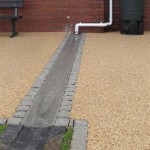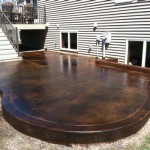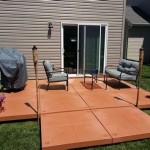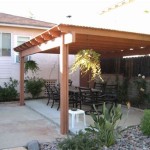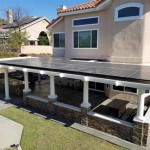Small Patio Design Ideas: Maximizing Limited Outdoor Space
Designing a small patio presents a unique set of challenges and opportunities. The key is to maximize every square inch, creating a functional and aesthetically pleasing outdoor space that feels larger than it actually is. Careful planning, clever use of furniture, and strategic implementation of design elements can transform a cramped area into a comfortable and inviting retreat.
Before embarking on any design project, it's crucial to assess the limitations and possibilities of the space. Consider the existing architecture of the house, the amount of sunlight the patio receives, and the surrounding landscape. This information will inform decisions about color palettes, materials, and plant selections. It’s also beneficial to consider the primary use of the patio. Is it intended for dining, relaxation, entertaining, or a combination of these? Defining the purpose early on will guide the design choices and ensure the final result meets specific needs.
Careful consideration should also be given to local building codes and any homeowner association regulations that may apply. These regulations might dictate permissible materials, sizes of structures, or even the color schemes allowed. Obtaining necessary permits before starting any construction or significant landscaping work is crucial to avoid potential problems and costly revisions later. A well-planned design incorporates these considerations from the outset, streamlining the process and ensuring a successful outcome.
Vertical Gardening and Space-Saving Furniture
One of the most effective ways to overcome spatial limitations in a small patio is to utilize vertical space. Vertical gardening techniques, such as installing wall-mounted planters, trellises, or living walls, can dramatically increase the amount of greenery without sacrificing valuable floor area. These features not only add visual interest and texture but also create a sense of privacy and enclosure. A variety of plants can be used in vertical gardens, including herbs, vegetables, flowering vines, and succulents, allowing for customization based on personal preferences and the patio's environmental conditions.
Space-saving furniture is another essential element of small patio design. Opting for multi-functional pieces, such as benches with built-in storage or folding tables and chairs, can maximize utility without cluttering the space. Consider using lightweight and portable furniture that can be easily rearranged or stored away when not in use. Small bistro sets are ideal for intimate dining, while modular seating can be configured to accommodate different group sizes. Choosing furniture with clean lines and a minimalist design can also contribute to a more spacious and uncluttered feel.
Integrating storage solutions seamlessly into the patio design is also important. Built-in benches with storage underneath can provide seating while also concealing gardening tools, cushions, or other outdoor accessories. Outdoor storage boxes, strategically placed and designed to blend with the overall aesthetic, can offer additional storage space without detracting from the patio's appearance. By carefully selecting and incorporating storage solutions, the patio can remain organized and functional, even with limited space.
The choice of materials for furniture and flooring can also significantly impact the perceived size of the patio. Lighter colors tend to make spaces feel larger and more open, while darker colors can create a more enclosed and intimate atmosphere. Consider using materials that reflect light, such as light-colored pavers or furniture with metallic accents, to enhance the sense of spaciousness. Durable and weather-resistant materials are essential for outdoor use, ensuring that the furniture and flooring can withstand the elements and maintain their appearance over time.
Creating Visual Interest and Defining Zones
Thoughtful design is crucial for creating visual interest and defining distinct zones within a small patio. Using different flooring materials, such as pavers, gravel, or decking, can help to delineate different areas, such as a dining area, a lounging area, or a gardening area. Varying the textures and colors of these materials can also add visual contrast and depth to the space. For example, using a combination of smooth pavers and textured gravel can create a visually appealing and tactile experience.
Strategic placement of plants and decorative elements can further define zones and enhance the overall aesthetic of the patio. Using potted plants of different sizes and shapes can create visual layers and add depth to the space. Tall plants can be used to screen off unwanted views or create a sense of privacy, while smaller plants can be used to add pops of color and texture. Integrating decorative elements, such as sculptures, fountains, or outdoor lighting, can also enhance the ambiance of the patio and create focal points that draw the eye.
Outdoor lighting plays a crucial role in creating a welcoming and functional patio, especially for evening use. String lights, lanterns, or strategically placed spotlights can illuminate different areas of the patio, creating a warm and inviting atmosphere. Consider using dimmable lights to adjust the ambiance according to the mood and activity. Solar-powered lights are a cost-effective and environmentally friendly option for adding subtle illumination to the patio. Well-placed lighting can also highlight architectural features, plants, or decorative elements, enhancing the overall visual appeal of the space.
The integration of water features, such as small fountains or birdbaths, can add a soothing and tranquil element to the patio. The sound of running water can help to mask unwanted noise and create a more relaxing atmosphere. Water features can also attract birds and other wildlife, adding to the natural beauty of the space. When choosing a water feature, consider its size, style, and maintenance requirements to ensure that it complements the overall design of the patio.
Color Palettes and Material Choices
Choosing the right color palette is essential for creating a cohesive and visually appealing small patio. Lighter and brighter colors tend to make spaces feel larger and more open, while darker colors can create a more intimate and enclosed atmosphere. Consider using a neutral color palette as a base and then adding pops of color through accessories, plants, and decorative elements. This approach allows for flexibility and easy updates as preferences change over time. Using complementary colors can create a sense of harmony and balance, while using contrasting colors can add drama and visual interest.
The selection of materials for flooring, furniture, and accessories is equally important. Durable and weather-resistant materials are essential for outdoor use, ensuring that the patio can withstand the elements and maintain its appearance over time. Consider using materials that are easy to clean and maintain, such as composite decking, powder-coated aluminum furniture, or weather-resistant fabrics. Natural materials, such as wood, stone, and wicker, can add warmth and texture to the patio, but they may require more maintenance to protect them from the elements.
Integrating textiles, such as cushions, throws, and rugs, can add comfort and style to the patio. Choose fabrics that are specifically designed for outdoor use and are resistant to fading, mildew, and water damage. Using a variety of textures and patterns can add visual interest and depth to the space. Consider using cushions with different shapes and sizes to create a more inviting and comfortable seating area. Adding an outdoor rug can help to define a specific zone and add warmth to the patio while grounding the furniture.
The integration of natural elements, such as plants, flowers, and natural stone, can enhance the beauty and tranquility of the patio. Consider using a variety of plants with different textures, colors, and heights to create visual interest and depth. Native plants are often a good choice, as they are well-suited to the local climate and require less maintenance. Adding flowering plants can add pops of color and attract pollinators, while using evergreen plants can provide year-round greenery. Integrating natural stone elements, such as pebbles, rocks, or stone pavers, can add texture and a natural touch to the patio.
Ultimately, the best small patio design is one that reflects personal style and meets individual needs. By carefully considering the limitations and possibilities of the space, utilizing vertical gardening and space-saving furniture, creating visual interest and defining zones, and choosing the right color palettes and materials, it is possible to transform even the smallest patio into a comfortable, functional, and beautiful outdoor retreat.

The Best Small Patio Ideas To Enjoy This Summer

40 Small Patio Ideas To Create A Cozy Outdoor Space

5 Small Patio Decor Ideas Decorilla Interior Design

95 Small Yet Cool Patio Decor Ideas Digsdigs

25 Small Backyard Ideas Landscaping And Patio Designs

15 Small Patio Ideas From Professional Designers

The Best Small Patio Ideas To Enjoy This Summer

43 Small Patio To Make Your Home Look Outstanding Tips Decor Outdoor Space Backyard Fall

Pictures And Tips For Small Patios

Garden Design Trends 2024 Solus Decor Small Patio Backyard Gardens
Related Posts

